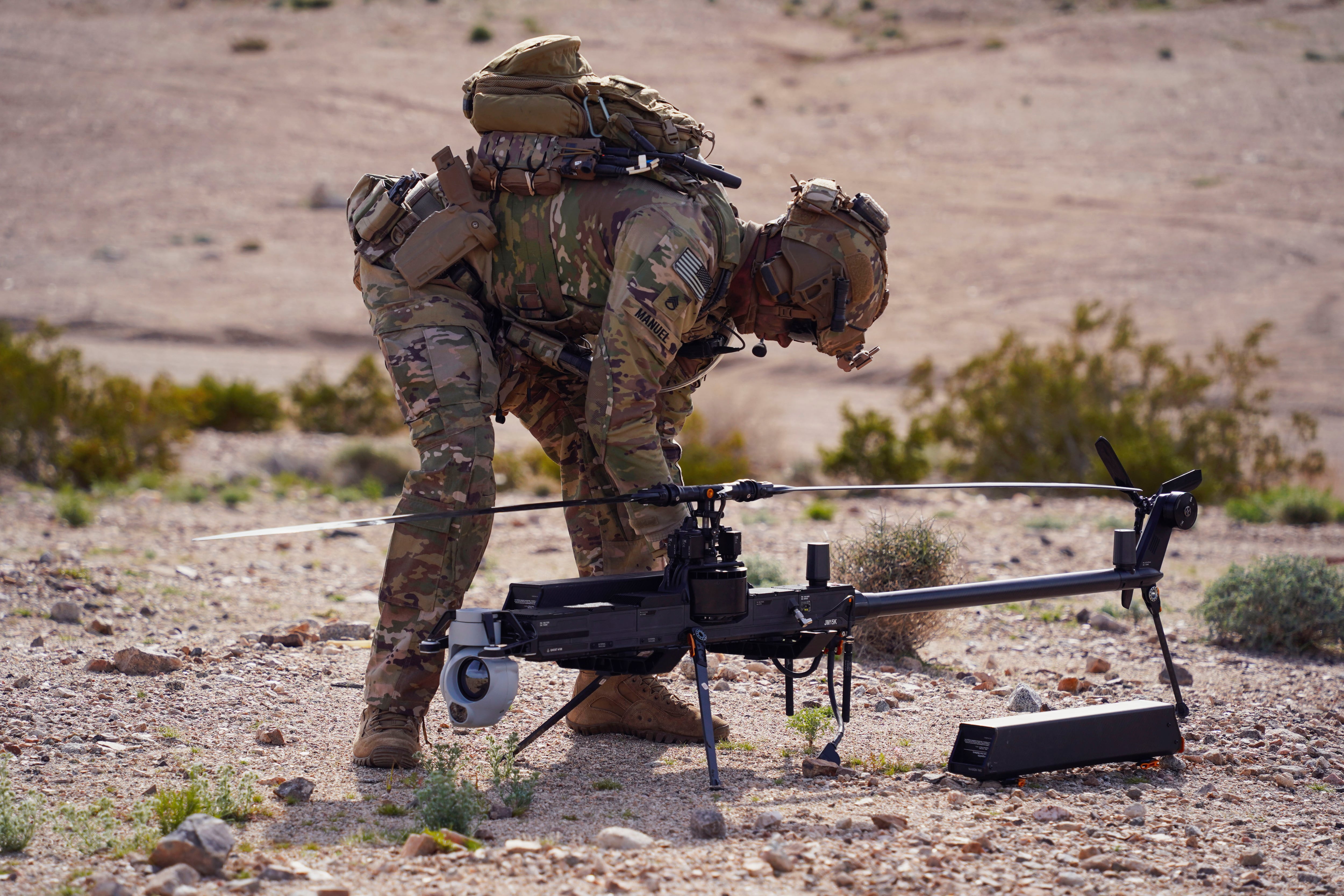FORT IRWIN, Calif. — Looking like a toy helicopter, a small black drone rose up over a cluster of adobe buildings in a quiet desert village, emitting a faint buzz.
The drone, an Anduril Industries’ Ghost-X, paused and then rose higher, disappearing into the clouds. Another followed.
Seemingly small and unthreatening, the drones were serving as the eyes of an infantry company concealed by the surrounding mountains and readying to reclaim a village held by the enemy.
And those drones were not alone.
All at once, an overwhelming group of air- and ground-based machine fighters burst onto the scene. An “octocopter” lumbered through the sky with precision munitions and other robots attached to its belly, dropping three 60mm mortar rounds on a roof and other small, hand-held, cylindrical “throwbots” on the ground.
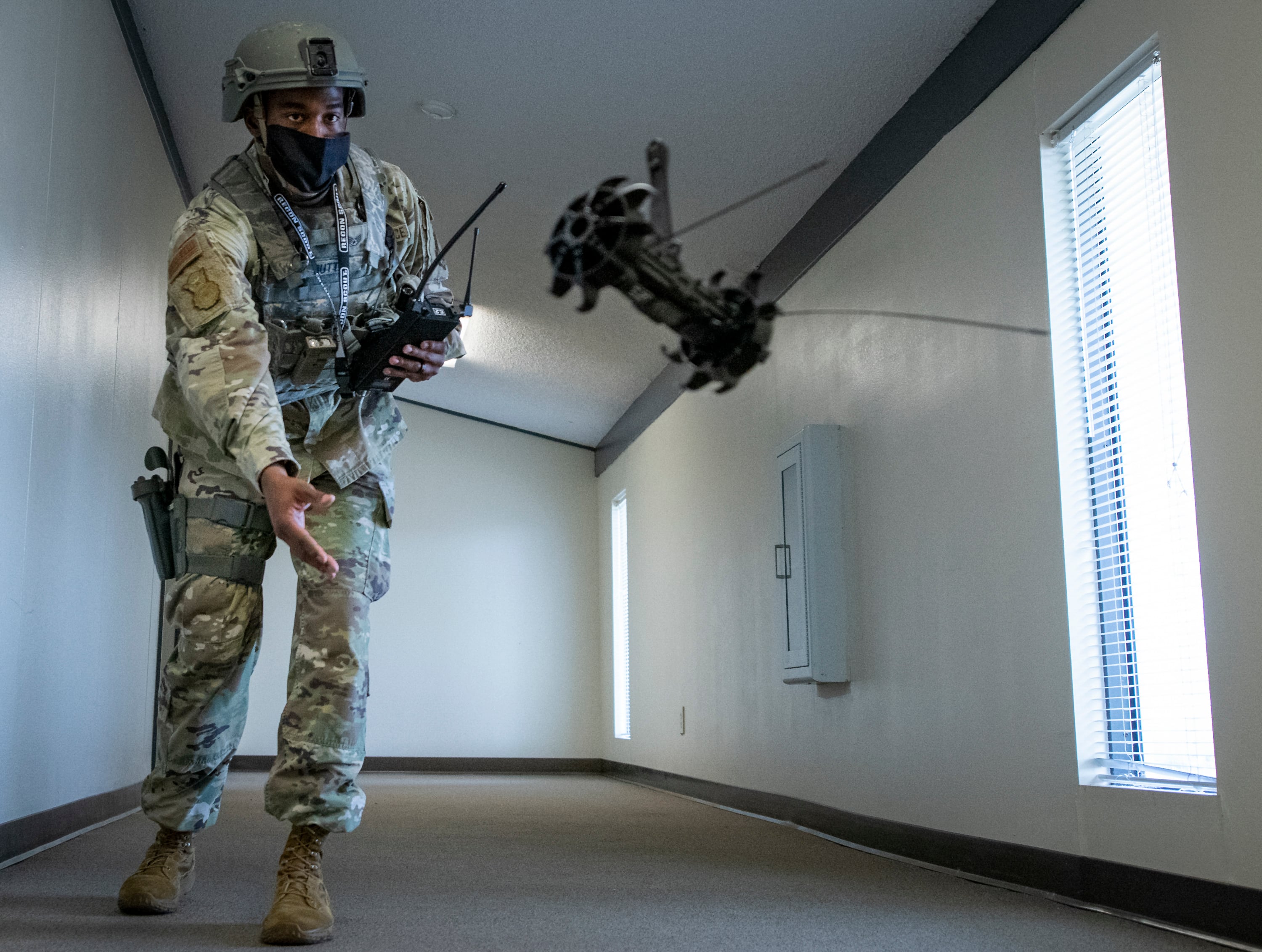
Robotic combat vehicles rolled into view, armed with .50-caliber and M240 machine guns, firing on enemy positions and providing cover for troops maneuvering into the village.
Meanwhile, a four-legged dog robot stepped out from a thick cloud of smoke, giving the soldiers monitoring from afar another view.
The scene was the culmination of a U.S. Army effort to understand how it can use humans and machines together on the battlefield. Service leaders descended on Fort Irwin, California — home to the National Training Center — in March for a large exercise known as Project Convergence.
The demonstration was a glimpse of the Army’s future, according to top officials. Gen. James Rainey, who leads Army Futures Command, expects the service’s future force to be so integrated with machines that humans will face a much lower risk.
“We will never again trade blood for first contact,” he frequently says, promising to deploy robots instead.
But getting these formations right won’t be easy, leaders acknowledge. For human-machine integration to work, a functional and user-friendly network must underpin it, it requires protection from cyberattacks, and the systems must have the right amount of autonomy.
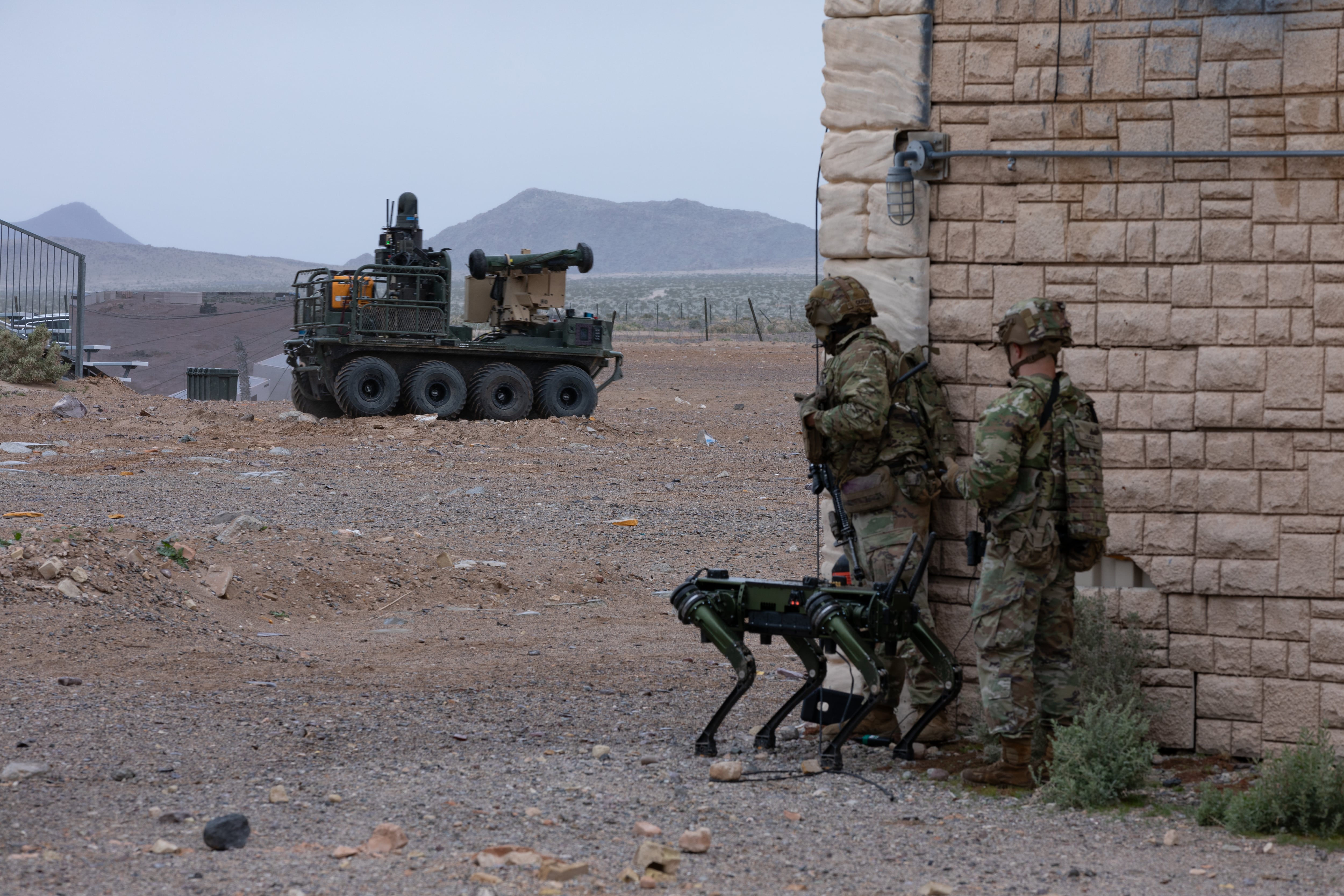
Leaders also say it’s not technology that will prove the most difficult factor, but rather breaking from antiquated acquisition processes that prevent rapid purchases and slow down deliveries to soldiers.
“The pace of the threat and the pace of technology — the evolution is much faster, and there’s no way that we’re going to succeed if we continue to acquire technology or even choose to develop” it at the usual pace, Joseph Welch, the Army’s C5ISR Center director, said at the March event.
Forward progress
The Project Convergence exercise followed months of effort focused on integrating humans and machines into service formations. It was a chance to see what works and what doesn’t as the Army prepares for a fight against adversaries with advanced capabilities.
The service insists it’s now ready to move forward with human-machine integrated formations.
The fiscal 2025 budget request marks the first time the Army has included funding for these formations, also called H-MIF. It’s seeking $33 million for the first step, which provides an initial human-machine integration capability to infantry and armor formations. The Army was experimenting with both at Project Convergence.
The service wants machines in these new formations to “offload risk” and provide soldiers with “additional information for decision making,” according to the service’s budget documents.
The Army’s Rapid Capabilities and Critical Technologies Office is spearheading the effort for Futures Command. The office is creating prototypes using existing air and ground robotic programs and payloads while incorporating common architecture, communications and network capabilities.
The FY25 funding, the Army has said, will fund the movement of concepts through prototyping as well as enable soldiers to evaluate them in exercises and experiments.
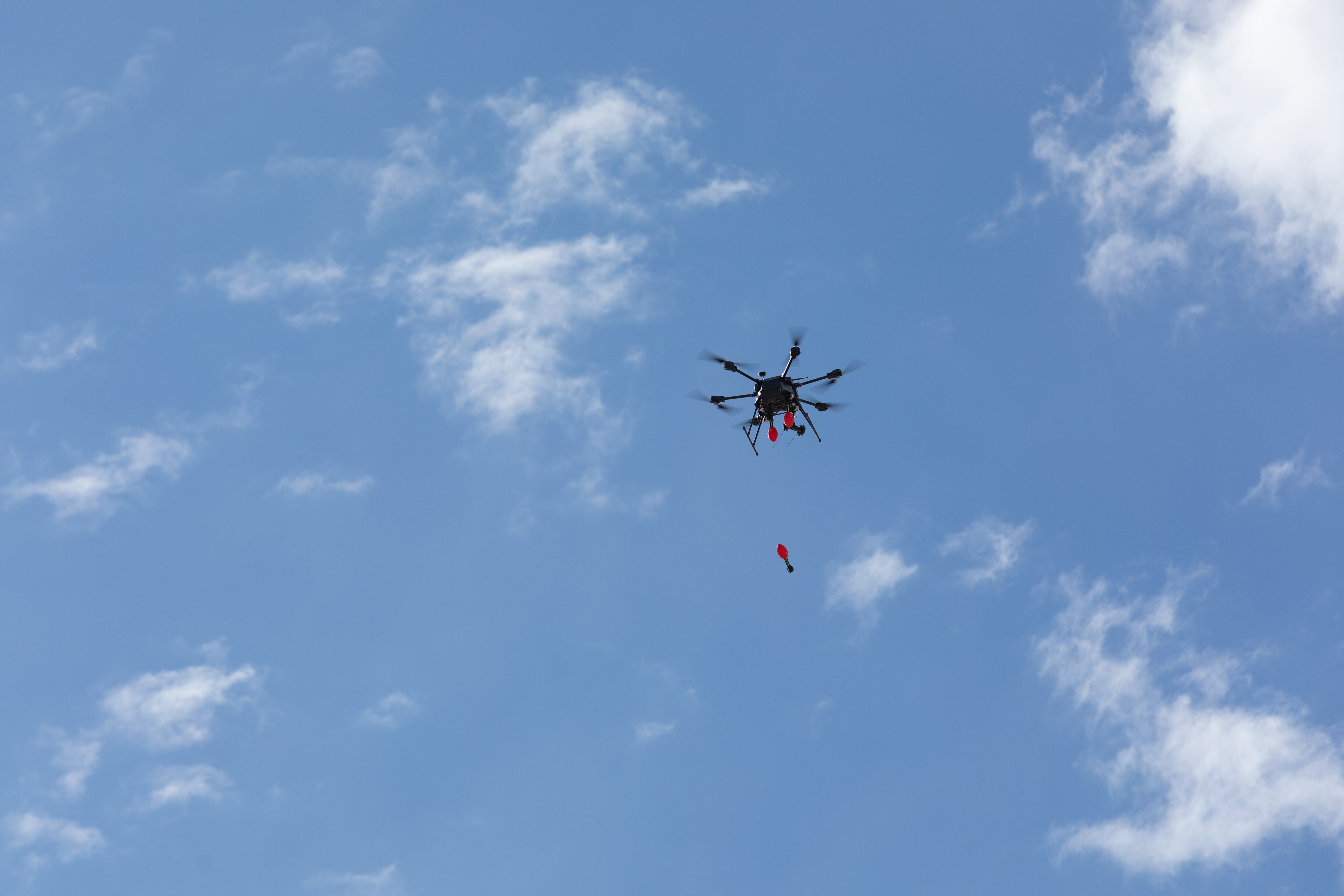
At the Project Convergence event, the Army flooded the battlefield with robots, sensors and other machines meant to help soldiers in complex flights. The experiment included air and ground robots with reconfigurable payloads, tethered drones, counter-drone systems, and a ventriloquist decoy emitter that emulates radio frequency traffic to confuse the enemy.
The service used more than 240 pieces of technology, including capabilities from allied militaries in the U.K., Canada, Australia, France and Japan.
The pressure to transform
The decision to rely more on robots isn’t a choice, according to Alexander Miller, who is now serving as chief technology officer to Army Chief of Staff Gen. Randy George.
George and Miller both watched the experiment in March; Miller carried a cellphone with an app demonstrating the Army’s new Tactical Assault Kit. The app superimposes the location of soldiers and robots as well as enemy positions in real time.
The service knows it has to do this, or “we will fall radically behind,” Miller said of human-machine integration. “There are bad people who are willing to use robotics, and if we don’t figure it out we will be behind the curve, we will put men and women in harm’s way.”
Integrating robots into formations is also accelerating because “there has been a cultural shift,” Miller said. “It’s been 12-18 months where we have stopped treating robots as a one-for-one augmentation for soldiers and started saying: ‘What are the dull, dirty, dangerous, disruptive things that robots can really do that are not just combat power? How do we augment them without taking a single rifleman off or multiple riflemen off the line to control a robot?’ ”
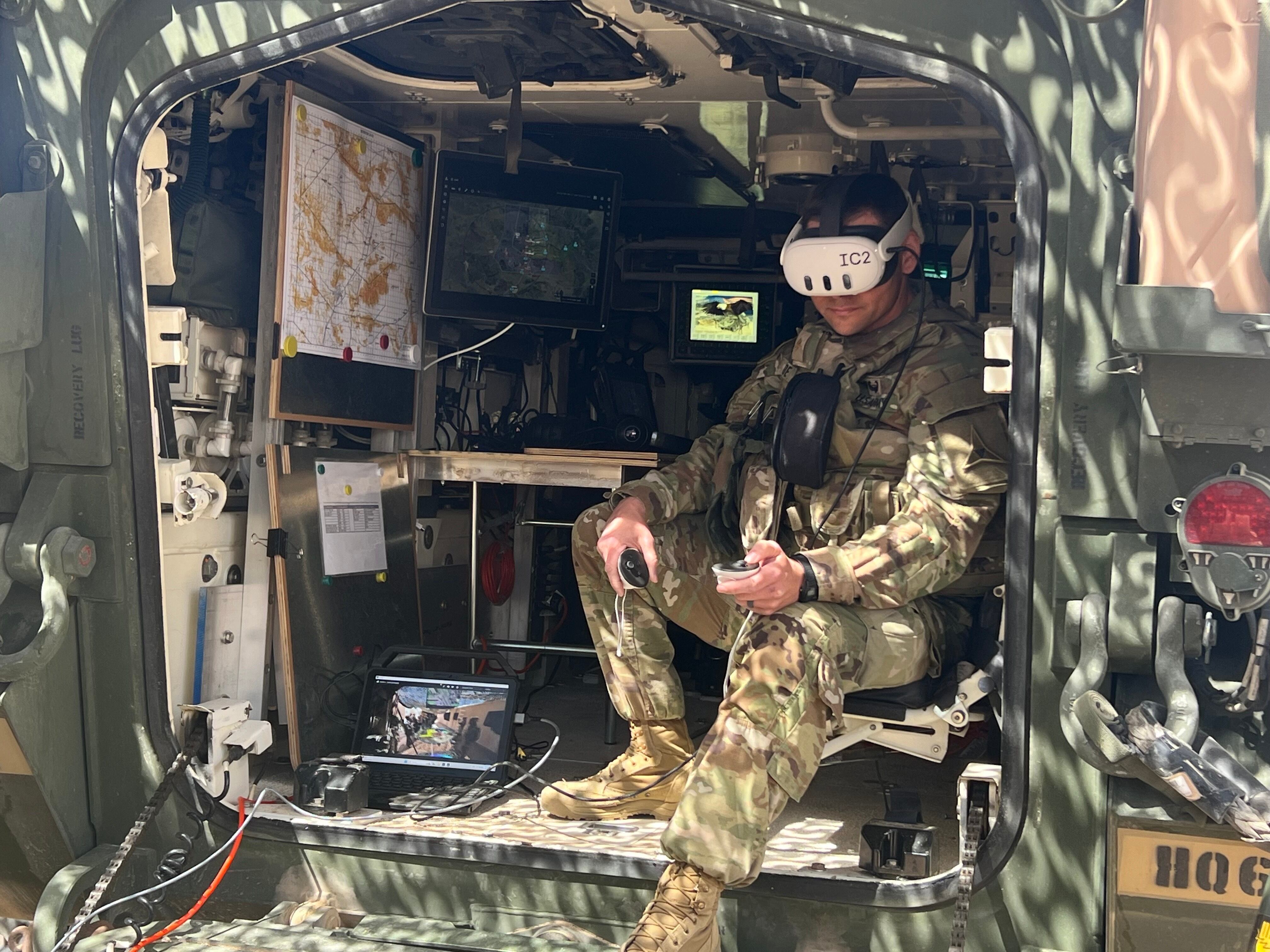
At the March experiment, for instance, the Army sent a ground robot with a mine-clearing line charge to deploy along enemy lines. As it fights the Russian invasion, the Ukrainian military is using these to disarm enemy minefields and trenches, but transporting them in crewed vehicles.
At the experiment, the robot shot the line charge out of a small launcher. The line didn’t explode as intended.
Army leaders said glitches are common and making this work would provide a much safer way for soldiers to clear mine fields.
Also enabling new models for human-machine integration is the progress of commercial technology, according to Welch. “That has accelerated tremendously across many different technical domains,” he said.
Artificial intelligence is getting smarter; sensors are getting smaller, lighter and more versatile; connectivity solutions are more abundant; and air-, ground- and space-based capabilities are easier to use.
Obstacles ahead
Army leaders acknowledge there is plenty of work ahead to integrate robots and soldiers on the battlefield. The experiment itself illustrated “just how complicated it’s going to be ... where we really proliferate lower-cost, cheaper options and we clutter the environment intentionally,” Miller said.
At one point during Project Convergence, the Army jammed itself, causing a friendly drone swarm to fall out of the sky. The service fixed the problem by turning on a capability allowing smart routing management for its Wi-Fi, Miller said.
Beyond technical challenges, George said, the Army must convince Congress to alter the procurement process so the service can acquire or adapt capabilities within broader funding lines. The goal, he explained, is to be more responsive to what is working for soldiers and to be able to rapidly buy small amounts of that equipment.
He said he’s working with Congress “so that we can move money a little bit.”
“We want and need the oversight, [but] it’s a matter of how we go back to them and tell them, ‘Here’s what we’re going to buy inside that funding line, and here’s how we’re doing it,’ and get feedback,” George added.
Indeed, one focus is on marking sure the Army can change systems without needing reprogramming authorization or new funding.
The technical and operational ways the Army is going to employ human-machine integrated formations today “doesn’t mean that’s how we’re going to employ it two years from now,” said Mark Kitz, the service’s program executive officer for command, control, communications-tactical.
“We don’t historically treat robotics as a software program. It’s really a software program,” Kitz explained. “So how do we use some of our unique acquisition authorities then to build that flexibility upfront?”
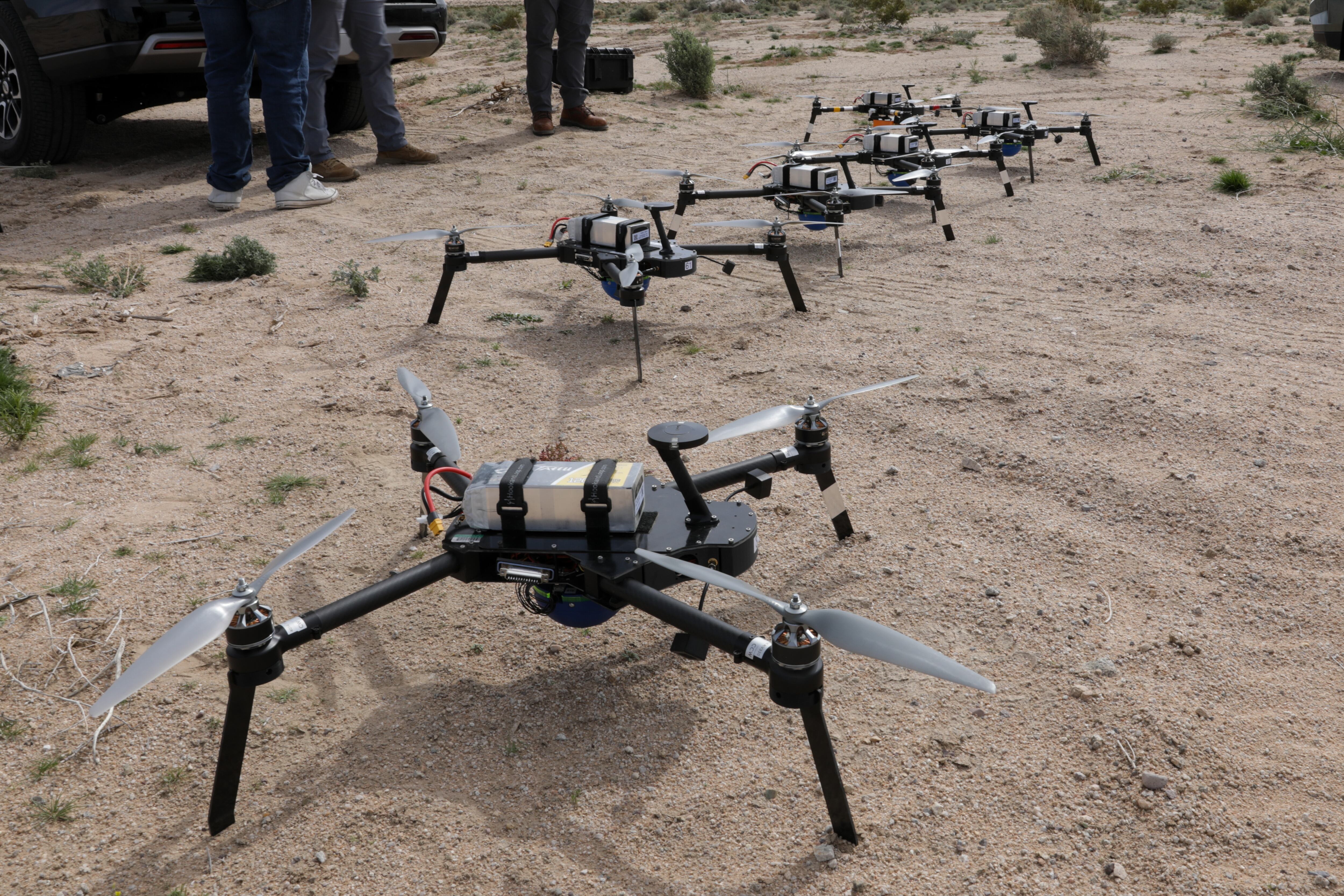
Miller said another potential obstacle is ensuring sufficient U.S. production of components.
“We have to have components that are approved and valid and we aren’t scared to employ because they were made by an adversary,” he said. Welch noted the Army is working with U.S. government labs to address some of the component concerns.
The service is also working internally to revamp its approach to finding capabilities.
“There’s a much tighter coupling ... not only externally with our industry partners and other key stakeholders, whether it be over on [Capitol] Hill or up in [the Office of the Secretary of Defense], but also internally,” said Lt. Gen. John Morrison, the Army’s deputy chief of staff in charge of command, control, communications, cyber operations and networks. “We’ve got requirements with acquisition, with testers, and they’re all centered around soldiers, getting that direct feedback.”
Benjamin Jensen, a senior fellow at the Center for Strategic and International Studies think tank where he focuses on wargaming, said he’s “optimistic” about human-machine integration but that it may take longer than the service expects.
“Most people overestimate the speed at which you can develop new concepts of employment around even proven engineering,” he said. “It often takes years outside of a major war to build entirely new formations and structures.”
Jen Judson is an award-winning journalist covering land warfare for Defense News. She has also worked for Politico and Inside Defense. She holds a Master of Science degree in journalism from Boston University and a Bachelor of Arts degree from Kenyon College.
